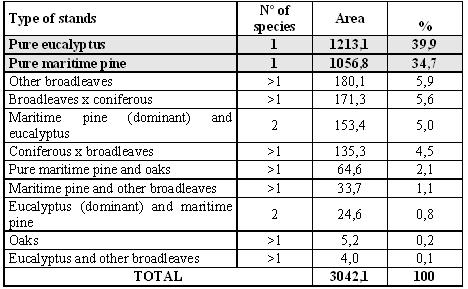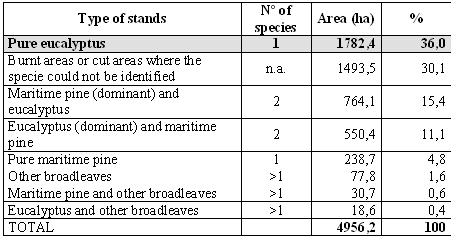Forest area covered (1995): 4956,1 ha
Percentage of the total forest covered: 14,3 %
Costs
TOTAL COST: 27 €
The total cost includes :
1- Data analysis : 27 €
Results
Trees species composition according to 1990 land use the South of Paredes
Source: COS 90
Trees species composition according to 1995 land use in the South of Paredes
Source: Interpretation of the aerial photograph of 1995 done and available at AFVS
Evolution of the main species between 1990 and 1995 in the South of Paredes
Remarks
In 1990, the most representative type of stands in the South of Paredes was pure stands of eucalyptus, about 40 % of the forest area, followed by pure stands of maritime pine, about 35% of the forest area.
In 1995, the percentage of pure stands of eucalyptus concerning the same area decreased to 36% and the percentage of pure stands of maritime pine declined to only 5 %. Mixed stands of maritime pine and eucalyptus increased from 5, 8% in 1990 to 26, 5 % in 1995.
Both in 1990 and 1995, mixed stands of coniferous and broadleaves, eucalyptus and other broadleaves and pure stands of broadleaves only represented small percentages of forest area in the South of Paredes,. It is likely that mixed stands of maritime pine and eucalyptus had become pure stands of eucalyptus in the last years.
The dominance of pure stands of eucalyptus and the small percentage of broadleaves in the South of Paredes revealed by data available was confirmed by the field team during the work developed in 2005 under FORSEE project: in the FORSEE 35 plots, 22 were in pure eucalyptus stands, 4 in pure Maritime pine stands and 8 in mixed maritime pine x eucalyptus. Some Quercus and strawberry trees appeared in 2 plots, one of eucalyptus and other of maritime pine.
The South of Paredes is then poor in terms of diversity of forest species. In 1990, about 75 % of the forest area presented only 1 forest specie, Maritime pine (34,4%) or Eucalyptus (39,9%). In 1995, the area with only 1 specie was reduced to 50% but with a decrease especially in the area of pure Maritime pine (from 34,4 to 4,8%).
Problems and improvements
Data available for 1990 do not distinguish the other species of broadleaves but only the main species as Maritime pine and Eucalyptus.
During the field work it was also possible to classify the tree species composition of FORSEE plots and to compare it with official data.
In terms of improvements, it would be important to assess this indicator for the remaining 5 municipalities of Sousa Valley (the North of Paredes, Penafiel, Paços de Ferreira, Felgueiras, Lousada and Castelo de Paiva) and to compare if there are differences per municipality. Under FORSEE project, the option was to use data on land use available at the moment and covering the South of Paredes where the field work was carried out. In the beginning of 2007 it was published the NFI 2005 which can be now used to calculate the percentages of the different types of tree specie composition in Sousa Valley.
Comments and conclusion
It is possible to assess this indicator using the attribute tables of digital land use maps for different years, 1990 and 1995. The field work is also a good practise to confirm the tree species composition in the area of study.
In terms of tree species composition, it is possible to conclude that in the South of Paredes, in both 1990 and 1995, the high percentage of forest was the one classified as having 1 specie and Eucalyptus the main specie.
Eucalyptus, being fast growing specie from which forest owners can take revenues after 12 years of rotation, is gaining area to Maritime pine and to other forest species. If a poor tree specie composition is correlated with biologic diversity, the South of Paredes presents a low level of biologic diversity.
The stands of mixed broadleaves, located mainly along the streams and where Oaks are predominant specie (according to the field work records), assume a high importance in terms of soil and water protection.
The assessment of the indicator tree species composition, defined as area of forest classified according to the number of tree species occurring and the forest type, is similar to what is asked for the assessment of the indicator forest structure considered by NP 4406 2003 in terms of type of forest structures (mono specific/mixed stands, regular/irregular stands).
The forest structure is one of the indicators of Criterion 1 (not Criterion 4) considered by NP 4406 2003. NP 4406 2003 considers that the structural variability of the forest stands has a big influence in the management and in the characteristics of the forest ecosystem. The variability of the vertical structure considers the crown distribution by hierarchic class and the variability of the horizontal structure considers the distribution by classes of diameter.
The simplified structures (mono specific or regular stands) optimize the forest production while the complex structures (mixed or irregular stands) are more effective on the provision of goods and services and in general present higher values of biologic diversity.



Initiative Communaitaire FEDER
INTERREG IIIB Espace Atlantique


